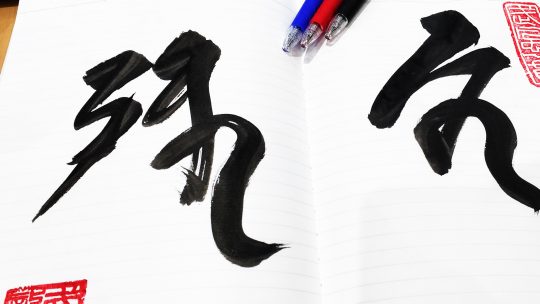文殊 MONJU (Guardian of the Law, Voice of the Law) is one of many meanings. Monju is considered the wisest of the Bodhisattva, and thus acts as the Voice (Expounder) of Buddhist Law.
Japanese sculptures of Monju often depict the deity sitting atop a roaring lion or shishi, which symbolizes the voice of Buddhist Law and the power of Buddhism to overcome all obstacles. Shishi are also commonly found guarding the entrance gate to shrines and temples. Monju typically holds the Sutra of Wisdom in the left hand and a sharp sword in the right, which Monju uses to cut through illusion and shed light on the unenlightened mind. In some artwork, Monju carries a lotus flower and sits atop a shishi (mythical lion).
Monju’s cult was introduced to Japan by Ennin 圓仁 (794-864 AD; also spelled 円仁), a Japanese monk who visited Wutaishan (a five-terraced mountain in China’s Shanxi Province that today is still a major center of the Monju cult) during his travels to China (838-847 AD).
Mañjuśrī is a bodhisattva associated with prajñā (insight) in Mahayana Buddhism. In Tibetan Buddhism, he is also a yidam. His name means “Gentle Glory” in Sanskrit.[1] Mañjuśrī is also known by the fuller name of Mañjuśrīkumārabhūta,[2] literally “Mañjuśrī, Still a Youth” or, less literally, “Prince Mañjuśrī”.
A mantra commonly associated with Mañjuśrī is the following:
oṃ arapacana dhīḥ
The Arapacana is a syllabary consisting of forty-two letters, and is named after the first five letters: a, ra, pa, ca, na
A is a door to the insight that all dharmas are unproduced from the very beginning (ādya-anutpannatvād).
RA is a door to the insight that all dharmas are without dirt (rajas).
PA is a door to the insight that all dharmas have been expounded in the ultimate sense (paramārtha).
CA is a door to the insight that the decrease (cyavana) or rebirth of any dharma cannot be apprehended, because all dharmas do not decrease, nor are they reborn.
NA is a door to the insight that the names (i.e. nāma) of all dharmas have vanished; the essential nature behind names cannot be gained or lost.
Tibetan pronunciation is slightly different and so the Tibetan characters read: oṃ a ra pa tsa na dhīḥ (Tibetan: ༀ་ཨ་ར་པ་ཙ་ན་དྷཱི༔, Wylie: om a ra pa tsa na d+hIH).[14] In Tibetan tradition, this mantra is believed to enhance wisdom and improve one’s skills in debating, memory, writing, and other literary abilities. “Dhīḥ” is the seed syllable of the mantra and is chanted with greater emphasis and also repeated a number of times as a decrescendo.

Bujinkan Keiko 2018
As far as the training goes, it is basically the same as previous years. A lot of Mūtō-dori against knife, sword and rokushakubō. Very often Sōke uses his fingers to “walk” across the hands, which finally captures a finger lock. He makes the attacker to forget he got a weapon in his hand and he just pick it out of the hand of the surprised Uke.
Even when it is Taijutsu, the concept of Mūtō-dori is the same principles used.
More about Monju.
More about Manjushri.